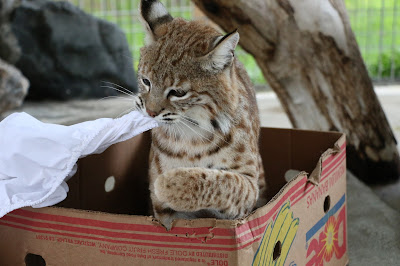Today we are pleased to introduce you to another of Wildwood Wildlife Park's dedicated zookeepers, Lindsay Krapfl and her favorite animal, Keeta, our one-year old female Bobcat.
The bobcat is the most common wildcat in North America and is named for its short, bobbed tail which appears to be cut or 'bobbed.' Its ears are black-tipped and pointed, with short black tufts of hair. Many people refer to the bobcat as a wildcat. While Wildcats are native to Africa, Europe and Asia, a bobcat is a small lynx of North America and are known as the North American Wildcat.
The bobcat prefers to live in woodland areas, but, unlike the lynx, it does not depend exclusively on deep forests. In addition to living in woods and forests these solitary animals can be found in swamps and semi-desert areas.
The bobcat is crepuscular, meaning that it is more active during the twilight hours just before dawn and dusk. During cold or the winter months it will often become active during the day.
Bobcats are amazing hunters - stalking its prey with both stealth and patience eventually capturing their meals with one leap. They are agile, climbing trees seemingly without effort and are also very good swimmers.
Bobcats are carnivores; their diet consists mainly of small animals including rabbits and hares and are also know to eat rodents, birds, and bats.
Bobcat's mating season is late winter, but anytime throughout the year is possible. Bobcat litters can be between 1-6 kittens that are usually born in the early spring. The kittens begin eating solid food around two months and begin learning to hunt at 5-months of age.
Like other cats the bobcat will often mew, hiss, growl ... and purr.
If you encounter Lindsay we hope you will thank her for sharing her passion for animals - or maybe just wave and "meow."



No comments:
Post a Comment